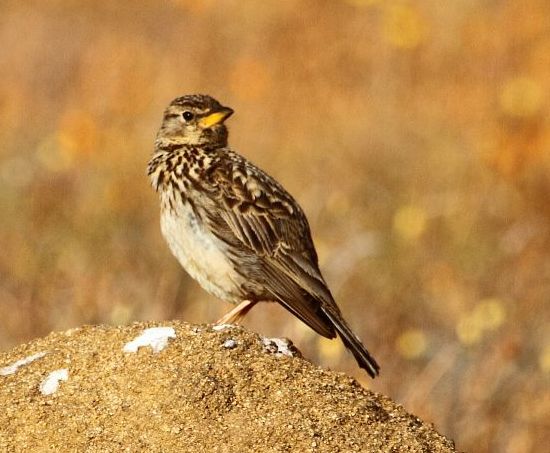| (11 intermediate revisions by the same user not shown) | |||
| Line 1: | Line 1: | ||
| − | [[ | + | [[Image:Lark Large-billed 2011 10 02 Alan Manson.jpg|thumb|550px|right|Photo by {{user|Alan+Manson|Alan Manson}} <br />Namaqua National Park, Northern Cape, [[South Africa]].]] |
| − | ;Galerida magnirostris | + | ;[[:Category:Galerida|Galerida]] magnirostris |
| + | |||
==Identification== | ==Identification== | ||
18 cm in length. Short tail, thick bill with a yellow base to the lower mandible. Streaked brown-grey upperparts, and a long white supercilium. Cream underparts with heavy dark streaking on the breast. The heavy bicoloured bill distinguished this species from all other African larks. | 18 cm in length. Short tail, thick bill with a yellow base to the lower mandible. Streaked brown-grey upperparts, and a long white supercilium. Cream underparts with heavy dark streaking on the breast. The heavy bicoloured bill distinguished this species from all other African larks. | ||
| − | The call of this very vocal species is is a soft creaking ''treeeeleeeeleee''. | + | The call of this very vocal species is is a soft creaking ''treeeeleeeeleee'' or ''tree-tiddley-pee''. |
==Distribution== | ==Distribution== | ||
| − | [[South Africa]], [[Lesotho]] and southernmost [[Namibia]]. | + | [[South Africa]] south of 27° S and west of 30° E, [[Lesotho]] and southernmost [[Namibia]]. |
| + | |||
==Taxonomy== | ==Taxonomy== | ||
| + | The only species of this genus in southern Africa. Five other ''[[:Category:Galerida|Galerida]]'' species are found in Eurasia and the rest of Africa. | ||
| + | |||
| + | Three subspecies are recognised, mainly on size. ''G. m. magnirostris'' from the coastal plain of South Africa's west coast and south-western South Africa, has a larger bill and shorter wing than the other subspecies. ''G. m. harei'' from the grasslands east of 24° E has a short and slender bill. ''G. m. sedentaria'' is found east of the nominate race in semi-arid karoo shrublands. It has more rufous upper parts than the other subspecies and longer wings and tail than the nominate race. | ||
| + | |||
| + | [[Image:2007_12_28_10_53_Large-billed_Lark.jpg|thumb|435px|right|Large-billed Lark (''ssp harei'') in dispaly flight<br />Photo by Alan Manson<br />Top of Sani Pass, KwaZulu-Natal Drakensberg, South Africa.]] | ||
| + | |||
==Habitat== | ==Habitat== | ||
| − | + | Grassland and shrubland. It is also found in cultivated and fallow agricultural land. | |
==Behaviour== | ==Behaviour== | ||
| − | Like other larks, it nests on the ground. | + | Like other larks, it nests on the ground. The male sings in display flight, from an elevated perch, or from the ground. Food is seeds and insects, the latter especially in the breeding season. |
| − | + | ==References== | |
| − | + | Hockey PAR, Dean WRJ & Ryan PG (eds) 2005. Robert's Birds of Southern Africa, 7th edition. John Voelcker Bird Book Fund, Cape Town, South Africa. ISBN 0620340533 | |
==External Links== | ==External Links== | ||
{{GSearch|Galerida+magnirostris}} | {{GSearch|Galerida+magnirostris}} | ||
| − | [[Category:Birds]] [[Category: | + | [[Category:Birds]] [[Category:Galerida]] |
Latest revision as of 09:16, 10 November 2011
- Galerida magnirostris
Identification
18 cm in length. Short tail, thick bill with a yellow base to the lower mandible. Streaked brown-grey upperparts, and a long white supercilium. Cream underparts with heavy dark streaking on the breast. The heavy bicoloured bill distinguished this species from all other African larks.
The call of this very vocal species is is a soft creaking treeeeleeeeleee or tree-tiddley-pee.
Distribution
South Africa south of 27° S and west of 30° E, Lesotho and southernmost Namibia.
Taxonomy
The only species of this genus in southern Africa. Five other Galerida species are found in Eurasia and the rest of Africa.
Three subspecies are recognised, mainly on size. G. m. magnirostris from the coastal plain of South Africa's west coast and south-western South Africa, has a larger bill and shorter wing than the other subspecies. G. m. harei from the grasslands east of 24° E has a short and slender bill. G. m. sedentaria is found east of the nominate race in semi-arid karoo shrublands. It has more rufous upper parts than the other subspecies and longer wings and tail than the nominate race.
Habitat
Grassland and shrubland. It is also found in cultivated and fallow agricultural land.
Behaviour
Like other larks, it nests on the ground. The male sings in display flight, from an elevated perch, or from the ground. Food is seeds and insects, the latter especially in the breeding season.
References
Hockey PAR, Dean WRJ & Ryan PG (eds) 2005. Robert's Birds of Southern Africa, 7th edition. John Voelcker Bird Book Fund, Cape Town, South Africa. ISBN 0620340533





